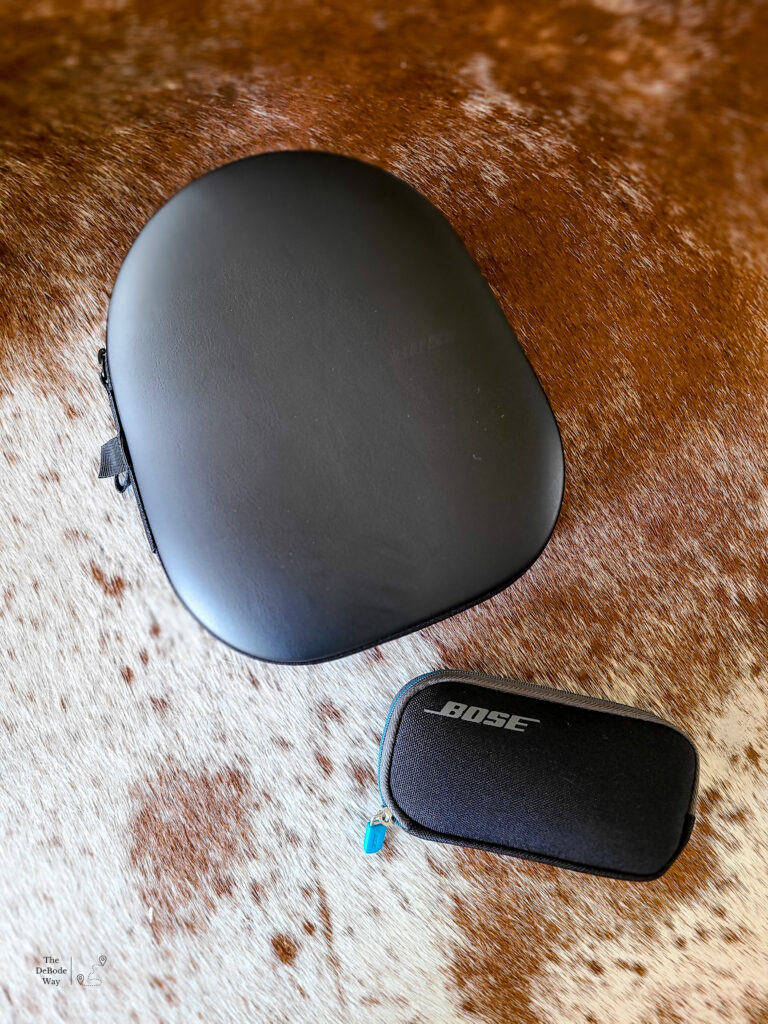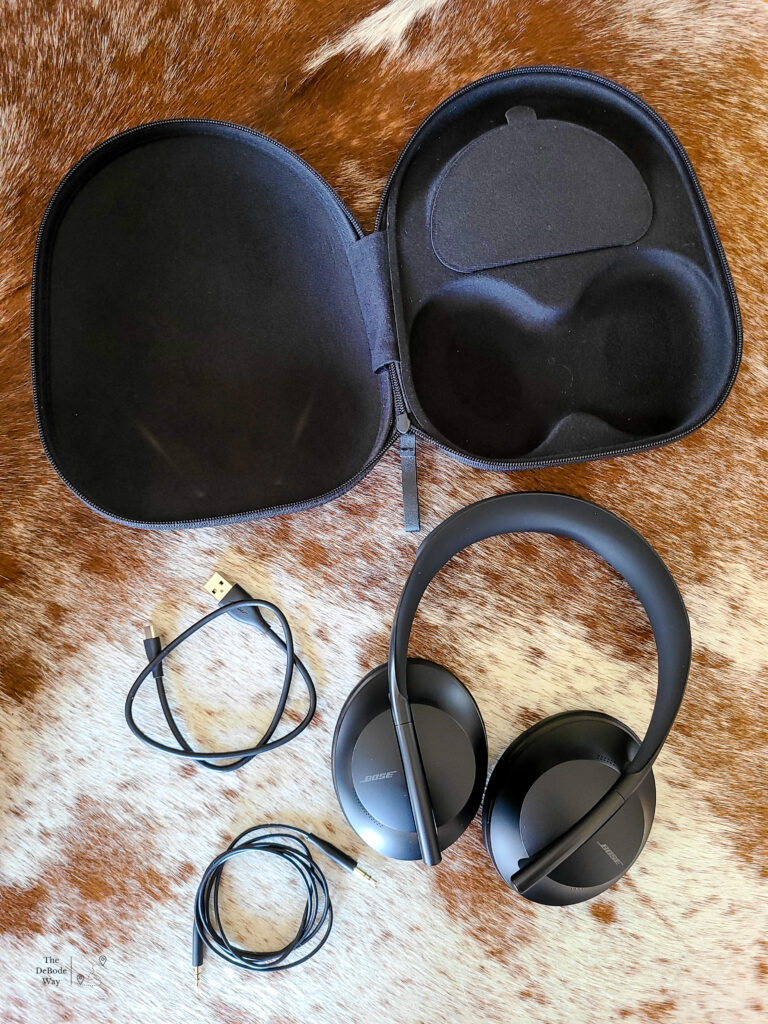This post contains Amazon affiliate links. We may earn commission on links you click or products you choose to purchase. Thank you.
In a prior travel technology post we talked about the benefits of noise-canceling earbuds for flights. Seriously, they’re amazing. You really can’t appreciate how loud a plane is until you’ve experienced noise-canceling technology…and then have to go without it. As we explained earlier, our first foray into the world of noise-canceling things was our Bose QuietComfort Noise-Canceling Earbuds. Lots of folks asked why we opted for earbuds rather than headphones, and our main answer was focused on their smaller size, which is helpful given our preference to travel only with carry-on luggage. However, Jason recently purchased a pair of Bose QuietComfort 700 Noise-Canceling Headphones, so now we’re able to compare the two.
Cost.
Headphones. When I bought them from BestBuy, my headphones cost $255.65 and were on sale. I suppose if you did enough sleuthing, you might find them less expensive somewhere else, but make sure you factor in the value of your time when doing all that looking around. Their regular price is $379, so I feel like I got a pretty good deal. Along with the carrying case, there’s a small compartment that includes an audio cord and a charging cable. The charging cable is USB-C and does not come with a wall adaptor. The audio cord is mostly for flights: the headphones have a Bluetooth connection to your devices, but most planes don’t have that capability…yet. Until then, you can use the cord to connect the headphones to the plane’s in-flight entertainment system, or you can purchase an additional Bluetooth adaptor unit like an AirFly for the cordless experience.
Earbuds. We got these a few years ago, so while we don’t remember what we paid back then, they currently go for $350. Along with the carrying case, the wired earbuds also come with a small USB charging cord, though they don’t come with a wall adaptor for the cord, or at least they didn’t when we got them. Also, be aware the cord ends in a regular headphone jack, so if you want them to use with your phone, you might need a dongle to convert it to either USB-C or the end that works with your iPhone.
Battery Life.
Headphones. I’ve been impressed with the battery life of the headphones. When fully charged, they can last for around 20 hours of noise-canceling bliss before needing a recharge.
Earbuds. I’m not actually sure how long the noise-canceling ability of the earbuds last, but it’s a long, long time. I’ve taken them on day-long travel adventures and never need to recharge them. I’ve even waited for a few days, used them again, and still didn’t have to recharge them. Fortunately, if the battery does die, you’re still able to use them like regular earbuds; not the case with the headphones.
Comfort.
Headphones. When you first put them on, the QuietComfort 700s are really comfortable. The parts that cover your ears have lots of cushy padding, so there’s no rubbing or hard surfaces to irritate your head handles. The band that goes over the top of your head is similarly padded, so it won’t hurt when it rubs against the top of your noggin. On a recent flight from Chicago to Edinburgh, Scotland (about 7 hours), the headphones remained comfortable the entire time. The only minor exception is if you’re wearing a ballcap: beware that the headband will put pressure on the button (is that what it’s even called?!) at the top of your hat, which can make your head a little sore. However, at least in my experience, that happens with all headphones, not just these.
Earbuds. Do your earbuds stay in? Yea? Good for you; wish I could say the same. Unfortunately, almost all the earbuds I’ve tried seem to wiggle their way out of my ear. This happens more when I’m up and moving around (or mowing, for example), but still seems to happen when I’m sitting down. Fortunately, the smart folks over at Bose seem to have a solution to this program. On their earbuds, there’s an extra piece of silicone that presses against the inside of your ear, holding the bud firmly, though comfortable, in place as long as you have them in. As good as that is, I can only have them in for around 4 hours until my ears start getting a little sore, and this is true both at regular times and while traveling and on flights.
Noise-Canceling Quality.
Headphones. The only way to describe this is an immersive experience. Once you slide these babies on (and remember to push the noise-cancelling button), the whole world fades away, or at least the sounds it makes. Or well, that’s mostly true. The thing is, the padding that goes around your ears that makes these so comfortable is also the thing that somewhat undermines the headphones’ noise-canceling abilities.
For example, if you’re wearing a hat, the slight difference in the surface where the end of the hat meets your head creates a small gap that can let noise in. In other words, you need that padding to create a seal around your entire ear for optimal noise canceling. It’s still good even with the small gap, but not as good as without.
This particular model of headphones also has 10 levels of noise-canceling. I’m not sure why you’d ever want less than a level 10, but the option is there if you want it.
Earbuds. Contrary to what I was expecting, I think the earbuds are actually better when it comes to noise-canceling ability. Why? Well, the folks at Bose had the good sense to create a funnel-shaped end on the part of the earbud that goes into your ear canal. That means the sound you want to listen to is channeled directly into your ear rather than played around your ear as with the headphones. All the silicone pieces of the earbud also create a pretty effective seal around your inner ear, making for a better noise-canceling experience. That all makes it easier for the noise-canceling technology to actually do its job. Because of that, I’d give a slight nod to the earbuds over the headphones in this category.
Also, unlike the headphones, the earbuds have a single noise-canceling level: on or off.
Sound Quality.
Headphones. Bose is known for the quality of its sound, especially the base, and these headphones do not disappoint. Putting them on and watching a movie or listening to music creates something like a surround sound-like experience, allowing you to get fully immersed in whatever you’re doing. As with the noise-canceling levels, there are a few other functions you can play around with to customize your experience.
Earbuds. Again, regardless of what you have, if it’s a Bose product the sound is going to be top-notch. These earbuds are great, as are our other Bose earbuds that aren’t noise-canceling. Are they as good as the headphones? No. Why? I’m not sure. Maybe the bigger size of the headphones (read below) give the engineers more space to pack in more abilities and features. Maybe it’s just my ears. Either way, while the sound is great, it’s not as immersive as with the headphones.
Size.
Headphones. As we alluded to earlier, the headphones are bigger and bulkier than the earbuds. A lot more. For me, that means if I’m trying to sleep on the plane (ha!), it’s not happening with my headphones on. Yes, they also take up more space in my backpack, though not as much as I’d expected. The ear cups fold out to the side, so the case they come in is relatively flat and makes for easier stowage.
Earbuds. Obviously, there’s no way for headphones to take up less space than earbuds, so no surprises here. Our earbuds come in a small zippered hard-ish shelled pouch that’s super easy to toss into a bag of nearly any size. They also fit nicely in the pocket of the seat in front of you. Yes, yes, I know how gross those are. That’s what Clorox wipes are for.

Overall Thoughts.
In the end, which option you go with is largely up to your personal preference. As I’ve said above, it’s hard to go wrong with a Bose product, so you’ll be well taken care of regardless of which way you go. That said, if you’re someone who has trouble sleeping on planes but still gives it the good college effort, the headphones might not be for you. However, if you’re able to sleep sitting up and/or with a neck pillow, it might not be a big deal. If, like me, you’re someone who continually gives the stink eye to the people sleeping on your flight, this difference might not matter at all to you.
Speaking strictly about price, I don’t think there’s a big enough difference to influence the purchase. You get what you pay for, so if you’re not willing to spend much on noise-canceling technology, just beware. On the other hand, if you view these as an investment in your comfort while traveling (or whatever you do with them), and are willing to spend the money, the prices are close enough that you can go either way.






